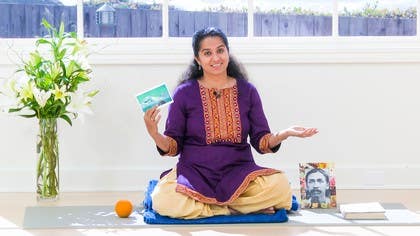Description
About This Video
Transcript
Read Full Transcript
Namaste friends. It's such fun doing Sanskrit with you. Let's get on to the third gender, the neuter gender. We've looked at masculine, feminine and the neuter. So here it is. Words in the neuter gender tend to end with mm as you would know by now if you've been watching the first two that you can't make any generalization. In fact, it's a fact with anything in life. The moment you make a complete generalization, you would have lost the truth of things because no two things are identical in life and therefore making any kind of broad generalization. Broad generalization is okay, but a sweeping generalization that would cover everything would do injustice to some important exceptions that are there within that category. So here we are with the neuter gender. One kind of broad generalization that we can make is when a word ends with mm and this is also in the subject case. We'll talk about that as it comes. So when a word in the subject case ends with mm like palam or fruit, then you would know that it's a neuter word. So palam, say that palam. Now close your eyes. Think of the fruit that you love. It's important to get the emotions in there. Think of the fruit that you love and say the sound for that word, palam. So you have more specific words for the different fruits, but I think for now we'll just talk of fruit in general, which is palam. Great. Push pam, the flower. Push pam. Once again, close your eyes. Think of a flower that you love and say the word push pam. Lovely. In terms of pronunciations, the sh is a cerebral one. So the tongue really has to go up there. So push pam. Say that. Very good. Another one. Very useful to help us remove all our obstacles. Pus takam. Pus takam. Say that. You can again think of a book that is your favourite. Close your eyes and say the word for a book. Lovely. Together, pus takam. The word for a photo is chitram. Say that. Chitram. Chitram also means very colourful, very varied. It can mean a few things. In Sanskrit, words don't necessarily mean just one thing. You can have many words to describe one object. So we have, for example, only a thousand words to describe the sun. So you can have a thousand words to describe the sun. And the same word can mean many things. So you have a word like ka gaha, which means a bird. But if you go to the etymology of the word, it is ka ga. Ka meaning space. Ga, that which goes. So anything that goes in space is ka ga. It could be a bird. It could be a cloud. So it depends on the context you're talking in. Right. So coming back to our picture, we have chitram. Very nice. A photo can also be referred to as chitram. But because it has to do with light, it's a light captured photo, we can use the word bha before it.
So it becomes very nice. Ba chitram. Did you get that? Ba chitram. You'll be amused. There's another word using chitram, which is to describe the film. What really is a film? The word in Sanskrit is chalana chitram. Chalana means walking. So it's walking or moving pictures. So that's the word for a film. Chalana chitram. Once more, there are some of these words that are helpful to remember because we'll use them later on when you talk of your favorite book, your favorite film, your favorite fruit, etc. All right. So talking about a few other things like in terms of relationships, when we talk of a friend, the word is in neuter. So it is mythram. Mythram. See that? Very nice. Our house is again in the neuter. Grham. See that? Very nice. Once more, very nice. The word for the body parts, two of them that are important. One is the eye, which is nithram. Say that. Nithram. Close your eyes. Point at your eye and say. Very nice. For the belly space, we've looked at it. Uda ram. Uda ram. Close your eyes. Feel your nice belly space and say that. Fantastic. The word for a scientific treatise or any systematized knowledge system is shastram. Say that. Shastram. It's any knowledge which has scientifically been presented. So you have shastrams of music, shastrams of painting, etc. Then we have the word that you are again familiar with is suthram in the yoga suthram. So it's a thread or a phorism. So suthram, also in the neuter. That which illuminates all our world is knowledge, which is again in the neuter. Janam. Say that. Janam by yourself. Very good. And finally, in the yoga world, something that we're all familiar with, various postures, again in the neuter. Asanam. Asanam. So make sure that your spine is nicely wrecked. Sit in a straight pose, in the lotus pose and say the word. You're allowed to cheat and take a more simple pose but. So asanam is the posture. Let's just revise all of this once again. The fruit is palam. Repeat it by yourself. Flower. Pushpam.
Very nice. Book. Pustakam. Lovely. Picture. Chittram. A photo or a light picture is a bha chittram. Very good. Like we have seen in the other two genders, there are exceptions. So be open to them. But on the whole, you can be confident that if a word in the subjective ends with an n, it would be a neuter. See you around with many more aspects of this language. Take care.







You need to be a subscriber to post a comment.
Please Log In or Create an Account to start your free trial.